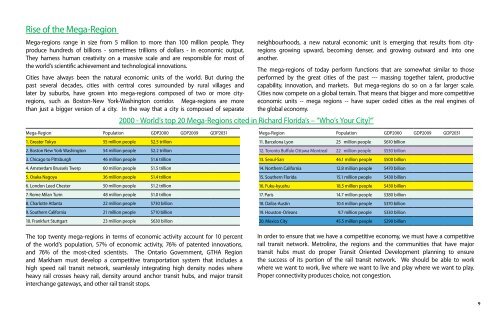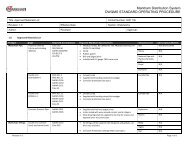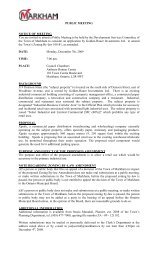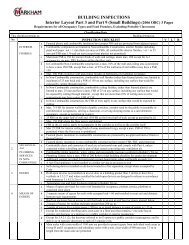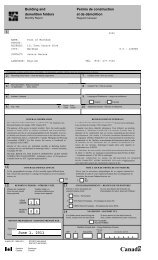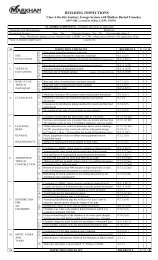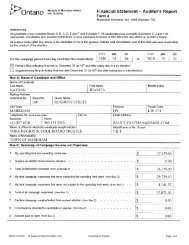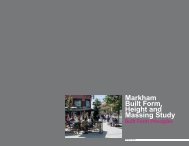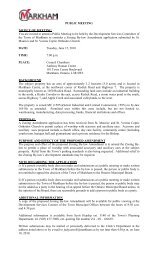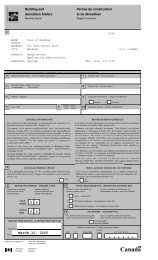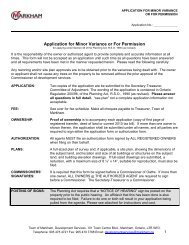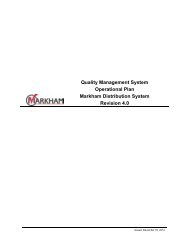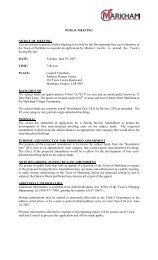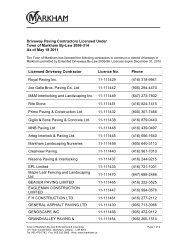1 4 7 10 11 12 2 5 8 3 6 9 - Town of Markham
1 4 7 10 11 12 2 5 8 3 6 9 - Town of Markham
1 4 7 10 11 12 2 5 8 3 6 9 - Town of Markham
Create successful ePaper yourself
Turn your PDF publications into a flip-book with our unique Google optimized e-Paper software.
Rise <strong>of</strong> the Mega-Region<br />
Mega-regions range in size from 5 million to more than <strong>10</strong>0 million people. They<br />
produce hundreds <strong>of</strong> billions - sometimes trillions <strong>of</strong> dollars - in economic output.<br />
They harness human creativity on a massive scale and are responsible for most <strong>of</strong><br />
the world’s scientific achievement and technological innovations.<br />
Cities have always been the natural economic units <strong>of</strong> the world. But during the<br />
past several decades, cities with central cores surrounded by rural villages and<br />
later by suburbs, have grown into mega-regions composed <strong>of</strong> two or more cityregions,<br />
such as Boston-New York-Washington corridor. Mega-regions are more<br />
than just a bigger version <strong>of</strong> a city. In the way that a city is composed <strong>of</strong> separate<br />
Mega-Region Population GDP2000 GDP2009 GDP2031<br />
1. Greater Tokyo 55 million people $2.5 trillion<br />
2. Boston New York Washington 54 million people $2.2 trillion<br />
3. Chicago to Pittsburgh 46 million people $1.6 trillion<br />
4. Amsterdam Brussels Twerp 60 million people $1.5 trillion<br />
5. Osaka Nagoya 36 million people $1.4 trillion<br />
6. London Leed Chester 50 million people $1.2 trillion<br />
7. Rome Milan Turin 48 million people $1.0 trillion<br />
8. Charlotte Atlanta 22 million people $730 billion<br />
9. Southern California 21 million people $7<strong>10</strong> billion<br />
<strong>10</strong>. Frankfurt Stuttgart 23 million people $630 billion<br />
The top twenty mega-regions in terms <strong>of</strong> economic activity account for <strong>10</strong> percent<br />
<strong>of</strong> the world’s population, 57% <strong>of</strong> economic activity, 76% <strong>of</strong> patented innovations,<br />
and 76% <strong>of</strong> the most-cited scientists. The Ontario Government, GTHA Region<br />
and <strong>Markham</strong> must develop a competitive transportation system that includes a<br />
high speed rail transit network, seamlessly integrating high density nodes where<br />
heavy rail crosses heavy rail, density around anchor transit hubs, and major transit<br />
interchange gateways, and other rail transit stops.<br />
neighbourhoods, a new natural economic unit is emerging that results from cityregions<br />
growing upward, becoming denser, and growing outward and into one<br />
another.<br />
The mega-regions <strong>of</strong> today perform functions that are somewhat similar to those<br />
performed by the great cities <strong>of</strong> the past --- massing together talent, productive<br />
capability, innovation, and markets. But mega-regions do so on a far larger scale.<br />
Cities now compete on a global terrain. That means that bigger and more competitive<br />
economic units -- mega regions -- have super ceded cities as the real engines <strong>of</strong><br />
the global economy.<br />
2000 - World’s top 20 Mega-Regions cited in Richard Florida’s – “Who’s Your City?”<br />
Mega-Region Population GDP2000 GDP2009 GDP2031<br />
<strong>11</strong>. Barcelona Lyon 25 million people $6<strong>10</strong> billion<br />
<strong>12</strong>. Toronto Buffalo Ottawa Montreal 22 million people $530 billion<br />
13. Seoul-San 46.1 million people $500 billion<br />
14. Northern California <strong>12</strong>.8 million people $470 billion<br />
15. Southern Florida 15.1 million people $430 billion<br />
16. Fuku-kyushu 18.5 million people $430 billion<br />
17. Paris 14.7 million people $380 billion<br />
18. Dallas-Austin <strong>10</strong>.4 million people $370 billion<br />
19. Houston-Orleans 9.7 million people $330 billion<br />
20. Mexico City 45.5 million people $290 billion<br />
In order to ensure that we have a competitive economy, we must have a competitive<br />
rail transit network. Metrolinx, the regions and the communities that have major<br />
transit hubs must do proper Transit Oriented Development planning to ensure<br />
the success <strong>of</strong> its portion <strong>of</strong> the rail transit network. We should be able to work<br />
where we want to work, live where we want to live and play where we want to play.<br />
Proper connectivity produces choice, not congestion.<br />
9


